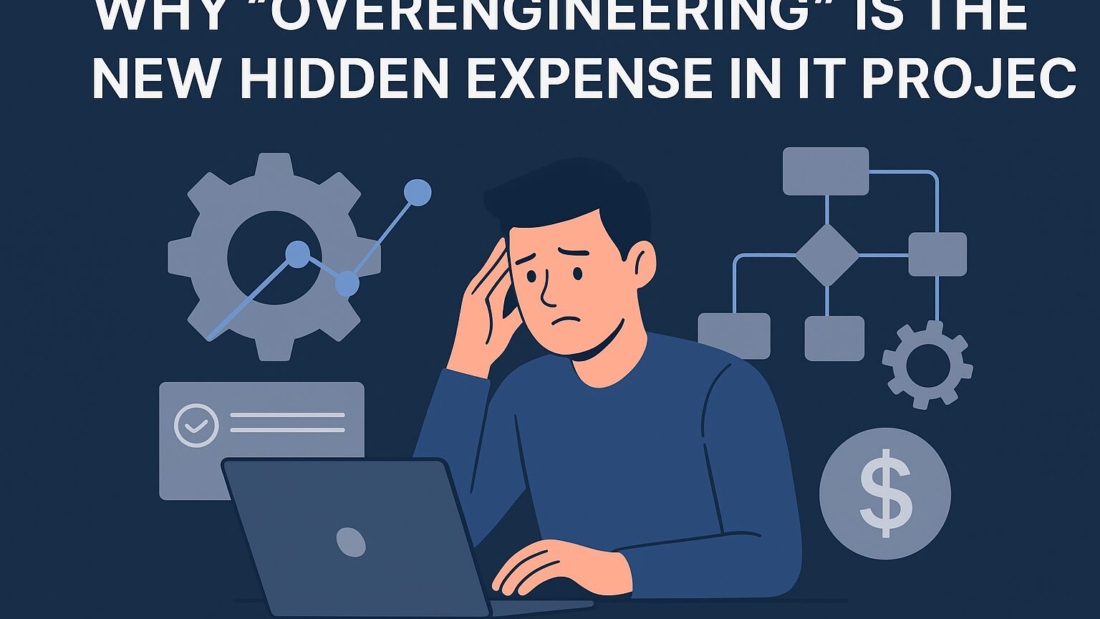In today’s fast-paced digital landscape, businesses invest heavily in IT projects to stay competitive. Whether it’s developing a new application, implementing enterprise software, or upgrading infrastructure, every decision carries weight in terms of cost, time, and long-term impact. Yet, there’s a silent budget-killer that organizations often overlook—overengineering.
Overengineering occurs when systems, applications, or processes are made unnecessarily complex, often in the pursuit of perfection, future-proofing, or showcasing technical prowess. While the intentions may be good, the outcome usually isn’t. Instead of creating scalable, efficient solutions, teams end up with bloated systems, spiraling budgets, and delayed timelines.
This article explores why overengineering has become the new hidden expense in IT projects, its impact on organizations, and strategies to keep it under control.
What Is Overengineering in IT Projects?
Overengineering refers to designing solutions with far more complexity than required to meet current needs. It often shows up as:
Building features “just in case” they’re needed in the future.
Adding multiple technology layers without clear justification.
Using advanced frameworks or tools when simpler ones would suffice.
Over-optimizing code, databases, or infrastructure beyond practical business needs.
Creating intricate architectures for small-scale projects.
At first glance, overengineering might seem like being thorough or proactive. But in reality, it often creates hidden costs that accumulate over the lifecycle of a project.
Why Overengineering Happens
Several factors contribute to overengineering in IT projects:
Future-Proofing Mentality
Developers and architects often want to design for scalability and future needs. While future-proofing has merit, it becomes problematic when teams try to anticipate every possible scenario, creating unnecessary complexity for today’s requirements.Technical Ego
Engineers sometimes choose complex tools or architectures to showcase their expertise, even when simpler solutions would achieve the same goal more efficiently.Unclear Requirements
When project requirements aren’t well-defined, teams tend to “cover all bases,” leading to feature creep and redundant complexity.Fear of Failure
Organizations sometimes overengineer out of fear that their system won’t hold up under pressure, leading to excessive safeguards and redundant layers.Pressure from Stakeholders
Stakeholders may push for extra features or sophisticated integrations that aren’t necessary, assuming that more complexity equals better quality.
The Hidden Costs of Overengineering
While the upfront expenses of overengineering are visible, the hidden costs are far more damaging in the long run.
Budget Overruns
Every additional feature, framework, or infrastructure layer adds cost. What starts as a well-planned budget can quickly balloon out of control.Delayed Timelines
Complex systems take longer to develop, test, and deploy. Teams often underestimate the added time, leading to missed deadlines and frustrated stakeholders.Increased Maintenance Burden
Overengineered systems are harder to maintain. Future developers must spend more time understanding the complexity, which increases operational costs.Reduced Agility
Ironically, the more “future-proof” a system is designed to be, the harder it becomes to adapt to actual future needs. Complex architectures often resist rapid changes.Team Burnout
Working on overly complex systems can frustrate developers, leading to burnout, high turnover, and decreased productivity.
Real-World Examples of Overengineering
Software Applications: A startup builds a mobile app with microservices architecture, multiple database systems, and advanced caching mechanisms—before even validating product-market fit. The result? Six months of wasted development and drained capital.
Enterprise Systems: An organization invests in an ERP system with hundreds of unnecessary modules, believing it will cover “every possible scenario.” In reality, most features remain unused while license fees pile up.
Infrastructure: A company sets up multi-cloud redundancy for a system that only supports a few hundred users, spending far more on infrastructure than the actual user base justifies.
How to Avoid Overengineering in IT Projects
The good news is that overengineering is preventable with the right mindset and practices.
Define Clear Business Requirements
Every feature or architectural decision should tie directly to a business objective. If it doesn’t serve today’s needs, defer it.Adopt Agile Methodologies
Agile frameworks encourage iterative development, allowing teams to build what’s needed now and adapt later without overbuilding upfront.Prioritize Minimum Viable Product (MVP)
Focus on delivering the smallest functional version of your solution that meets current requirements. Enhance later based on actual user feedback.Regularly Review Scope
Schedule checkpoints with stakeholders to ensure added features or complexities are still aligned with business goals.Encourage Simplicity in Architecture
Train architects and developers to value simplicity. A lean, efficient system is often more valuable than an overly complex one.Perform Cost-Benefit Analysis
Before implementing additional features or frameworks, weigh the cost against the tangible business value it delivers.
The Balance Between Innovation and Simplicity
Avoiding overengineering doesn’t mean stifling innovation. It’s about striking the right balance between robust solutions and practical business needs. Teams should be encouraged to innovate, but within the boundaries of clear requirements and realistic budgets.
Organizations that master this balance not only save costs but also gain a competitive edge by delivering projects faster, adapting more easily to change, and keeping developers motivated.
Conclusion
Overengineering is the new hidden expense in IT projects. While it often stems from good intentions—such as future-proofing or ensuring quality—it ultimately drains resources, delays delivery, and creates long-term inefficiencies.
By keeping business needs front and center, embracing simplicity, and avoiding the temptation to overbuild, organizations can ensure their IT projects deliver true value without unnecessary complexity.
The next time your team proposes an “extra” layer of sophistication, ask this simple question: Does this solve a problem we face today, or are we solving a problem that doesn’t exist yet? The answer might just save your project millions.

